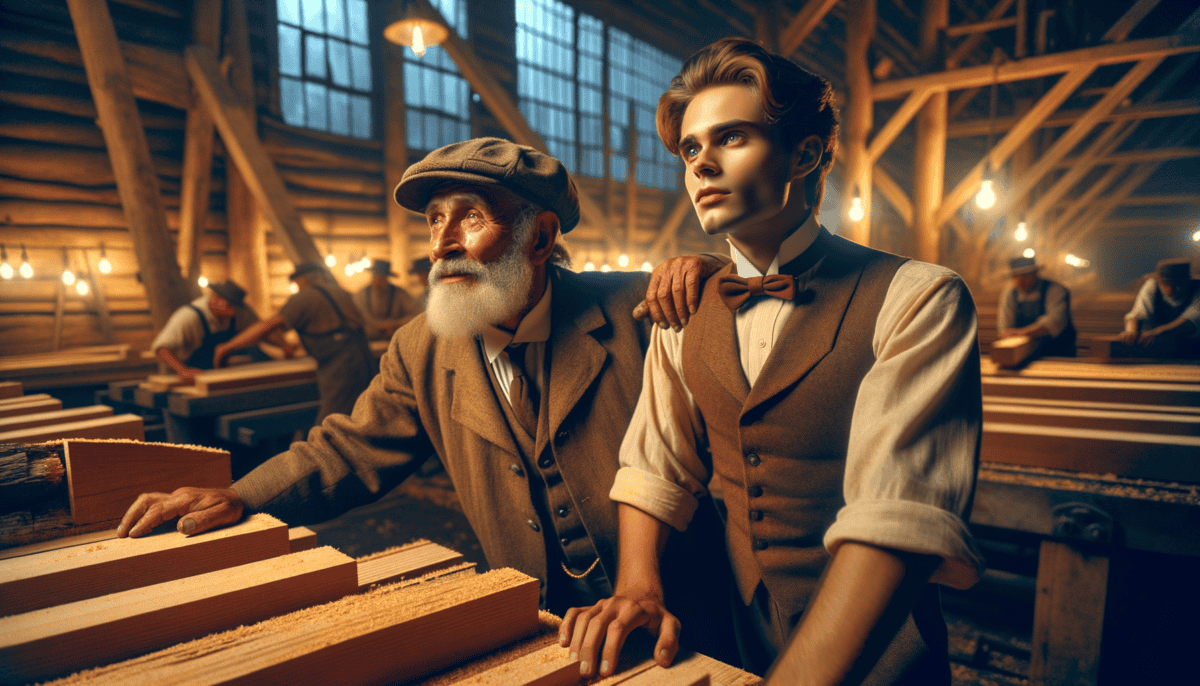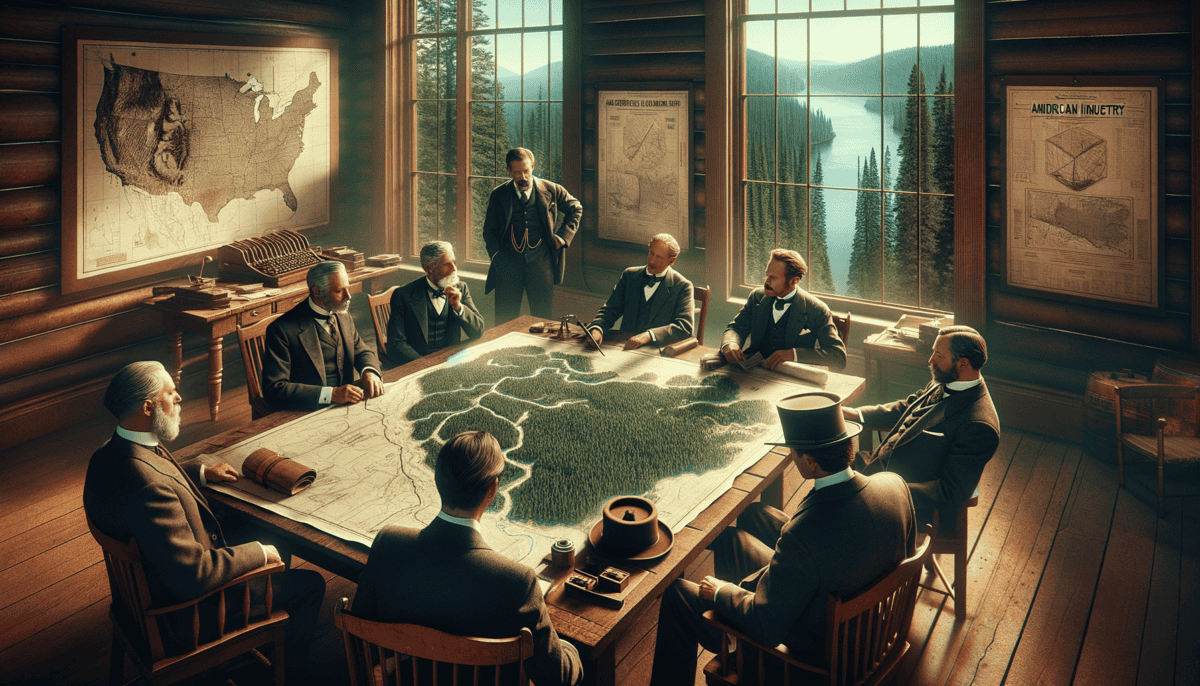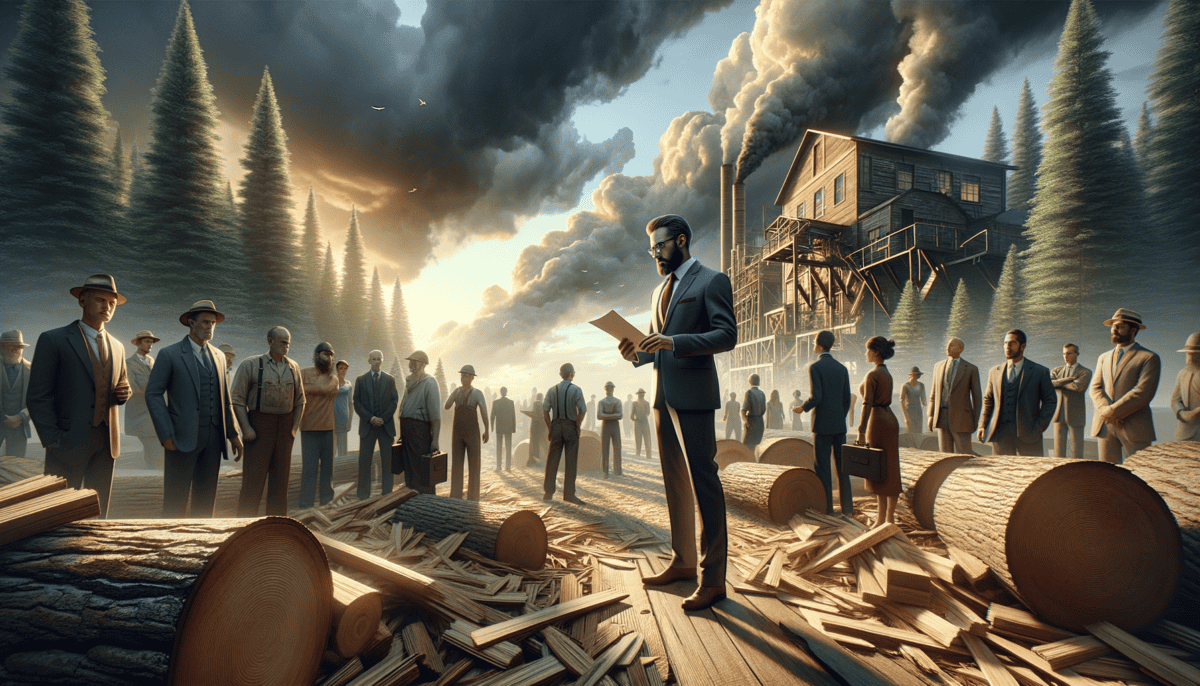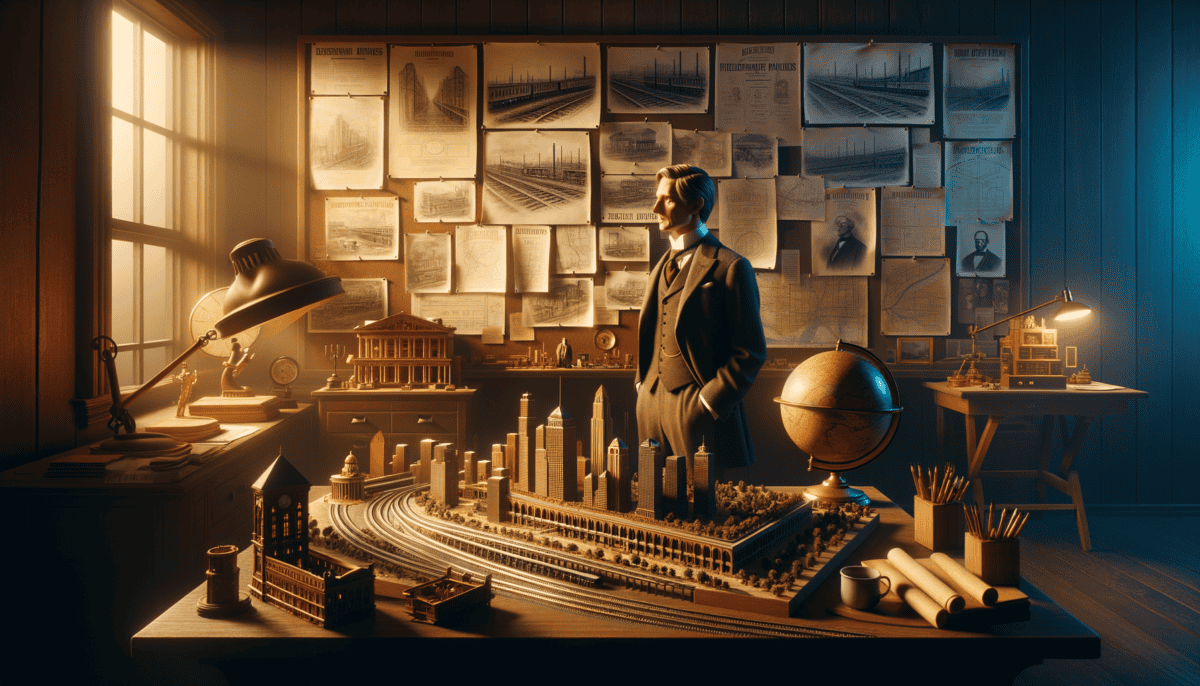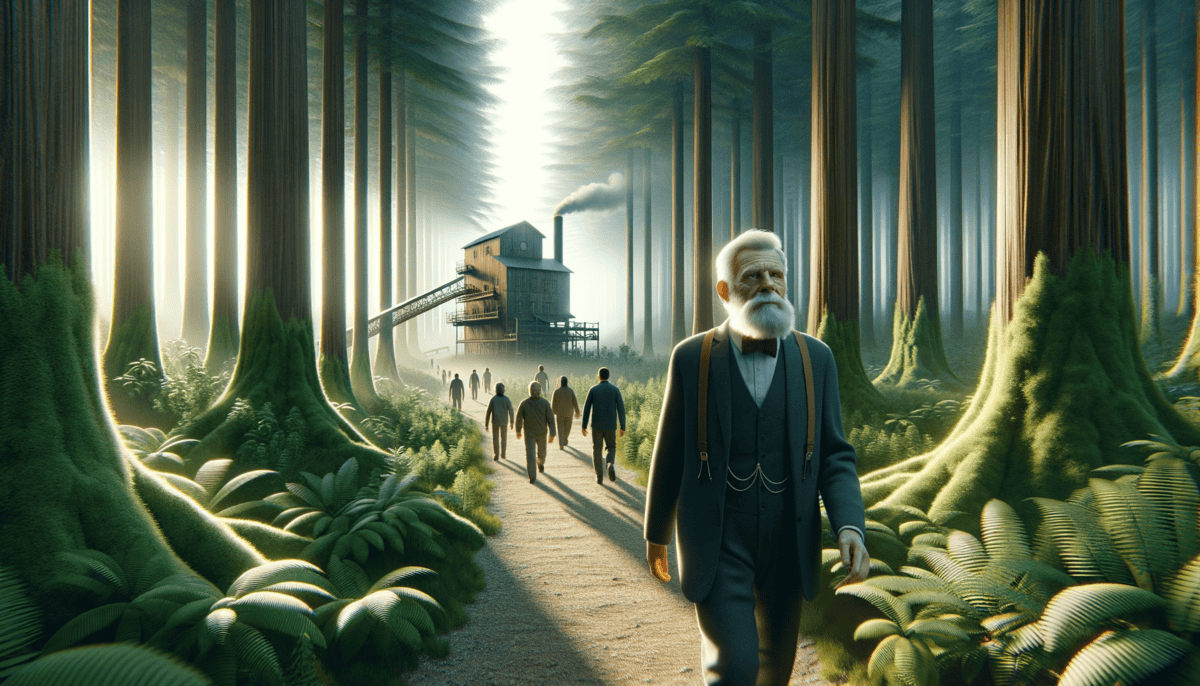A Boy’s Dream Across the Ocean
The cold wind whipped across young Frederick's face as he stood on the deck of the creaky wooden ship. The year was 1852, and at just 18 years old, Frederick Weyerhaeuser was leaving his home in Germany for America.
"Look, Fritz!" his sister called out, using his childhood nickname. "I can still see Germany behind us!"
Frederick smiled, but his heart felt heavy. Back home in Niedersaulheim, his family had struggled to put food on the table. Their small farm wasn't doing well, and times were tough. But America promised something different – a chance to build a better life.
The ocean journey wasn't easy. The waves rocked the ship day and night. Many passengers got sick. But Frederick stayed strong. He spent his time learning English words from a small book he carried:
"Tree"
"Work"
"Money"
"Dream" ⭐
After six long weeks at sea, something magical happened. Through the morning fog, Frederick saw a tall green statue. The Statue of Liberty wasn't there yet – it would come later. But the sight of New York Harbor made his heart jump with joy.
A New World of Wonder
"Welcome to America!" shouted a sailor as their ship pulled into the busy port. Frederick couldn't believe his eyes. There were so many people! So many buildings! And best of all – so many trees in the distance.
But life wasn't easy right away. Frederick had only four dollars in his pocket. He didn't speak much English. Finding work was hard. Some nights, he went to bed hungry, just like back home.
“I will make something of myself in this new land,” Frederick promised himself. “I just need to work hard and be patient.”
His first job was sweeping floors in a brewery. It wasn't much, but it was a start. Every day, Frederick watched the big ships bringing lumber into the port. He saw how important wood was for building houses, furniture, and ships.
The First Step Forward
One day, Frederick heard about better jobs in the west. Places like Illinois needed strong workers for their sawmills. The pay was better, and there were endless forests to explore.
"I'm going west," he told his sister. "That's where I'll find my future."
With hope in his heart and dreams of success, Frederick packed his few belongings. He had no idea that one day he would become one of the most important lumber businessmen in America. All he knew was that he was ready to work hard and learn everything he could about trees and lumber.
As the train chugged west toward Illinois, Frederick watched the forests roll by. Each tree seemed to whisper possibilities. In his pocket, he still carried his little English book. But now he had added a new word:
"Success"
Frederick may have left Germany behind, but he was carrying something more valuable than money – determination. His journey across the ocean was just the beginning of an amazing American story.
From Sawdust to Success
The sawmill rumbled and roared as Frederick stepped inside for his first day of work. The year was 1852, and the air was thick with sawdust in Rock Island, Illinois.
“Watch and learn, young man,” said Mr. Mead, the sawmill owner. “Every piece of wood has a story to tell.”
Frederick started at the bottom, sweeping sawdust and stacking boards. His arms ached every night, but he didn’t mind. He was learning something new each day:
• How to tell different types of trees apart
• The best way to cut lumber
• How to work the big saw machines
• Ways to sell wood to customers
Learning from the Best
Mr. Mead noticed how hard Frederick worked. “You have good eyes, boy,” he said one day. “You see things others miss.”
Frederick smiled. He was getting better at speaking English too. Now he could talk to customers and learn about the business side of lumber.
“The secret isn’t just cutting trees,” Mr. Mead taught him. “It’s knowing which trees to cut and when to cut them.”
Making His First Dollar
After a year of hard work, Frederick had saved enough money to buy a small load of lumber himself. He sold it for a profit!
“You’re a natural businessman,” said Sarah Bloedel, whose father owned another sawmill. Sarah would later become very important in Frederick’s life.
Big Dreams Taking Root
Frederick started making small deals. He would buy wood when prices were low and sell it when prices were high. He wrote letters to his family back in Germany:
“Dear Family,
America is full of trees as far as I can see. One day, I will own my own sawmill. Maybe even more than one!
Love, Frederick”
Building Trust
Other lumber workers liked Frederick. He was honest and worked hard. When he made a promise, he kept it. People started calling him “Honest Fritz.”
One cold winter morning, Mr. Mead called Frederick into his office.
“You’ve learned well, Frederick,” he said. “How would you like to be my partner in a new sawmill?”
Frederick could hardly believe his ears! This was his big chance. He had learned so much in just a few years:
Frederick’s Growing Knowledge:
Types of trees and their uses
How to run a sawmill
Business skills
Working with people
Making smart choices
A New Chapter Begins
Frederick said yes to Mr. Mead’s offer. He wasn’t just a worker anymore – he was becoming a businessman! His dreams were growing as tall as the trees he loved.
At night, Frederick would look at the stars and think about his journey. From a poor farm in Germany to becoming a sawmill partner in America – and this was just the beginning!
The sawdust that covered his clothes every day wasn’t just mess anymore. To Frederick, it was like gold dust, showing the path to his future success.
The Forest King Rises
The year was 1856, and Frederick Weyerhaeuser stood at the edge of a vast forest in Illinois. His eyes sparkled as he looked at the tall trees.
Smart Moves
“This land,” Frederick said to his friend Sarah Bloedel, “will be perfect for our new sawmill.” Sarah nodded in agreement. They had just gotten married, and both knew a lot about lumber.
Frederick had a clever plan. Instead of just buying wood from others, he would:
• Buy forests
• Build his own sawmills
• Sell the lumber himself
• Use boats to move wood on rivers
Making Friends in High Places
Frederick knew he couldn’t do everything alone. He made friends with other smart business people. One day, he met James J. Hill, who owned many trains.
“Frederick,” James said, “my trains can carry your lumber all across America!”
“Together,” Frederick replied, “we can build something bigger than just a sawmill. We can build an empire!”
New Ways to Cut Trees
Frederick always looked for better ways to do things. He bought new machines that could cut trees faster and better.
Frederick’s Smart Ideas:
Better cutting tools
Using rivers to move logs
Building bigger sawmills
Keeping good records
Working with others
Money Growing on Trees
Frederick’s business grew bigger and bigger. He was making more money than he ever dreamed of back in Germany. But he never forgot where he came from.
“Every tree we cut,” he told his workers, “means jobs for families and homes for people to live in.”
The Big Purchase
In 1870, Frederick made his biggest move yet. He bought a huge forest in Minnesota! It was so big, it would take days to walk across it.
“Papa,” his daughter asked, “why do you need so many trees?”
“Because America is growing,” he answered with a smile. “And growing countries need lots of wood to build new towns and cities.”
A Growing Forest Kingdom
By 1880, Frederick owned many sawmills and forests. People started calling him the “Lumber King.” But he was different from other rich business owners.
He built houses for his workers and their families. He made sure everyone got paid fairly. His workers liked him because he cared about them.
Looking to Tomorrow
As his business grew bigger, Frederick thought about the future. He knew trees took a long time to grow. So he started planting new trees where old ones were cut down.
“We must think about tomorrow,” he told his children. “The forests we plant today will be here for your children and their children too.”
Frederick’s dream had grown from a single sawmill to a huge lumber business. But this was just the start of his amazing story. More challenges and adventures were waiting just around the corner…
Storm Clouds Gather
The year was 1893, and dark clouds were gathering over Frederick Weyerhaeuser’s lumber empire. The country was going through hard times. Many banks were closing, and people weren’t buying as much wood. ️
Tough Times
Frederick stood in his office, looking at the pile of bills on his desk. Many of his friends had lost their businesses. But Frederick wasn’t going to give up.
“What will we do, Papa?” asked his son John.
“We will do what trees do in a storm,” Frederick smiled. “We will bend, but we will not break.”
Smart Choices
Frederick made some clever moves to save his business:
• Saved money by cutting fewer trees
• Kept his best workers
• Found new ways to sell lumber
• Helped other lumber companies stay open
• Made his mills work better
Racing Against Nature
Mother Nature gave Frederick more problems to solve. Sometimes forest fires would burn his trees. Other times, bugs would eat them.
Frederick’s Nature Solutions:
Built fire towers to spot fires early
Planted different kinds of trees
Had forest doctors check the trees
Made pools to help stop fires
Big Competition
Other lumber companies tried to take Frederick’s business. They cut prices and tried to buy his forests. But Frederick was smarter. He worked with them instead of fighting them.
“There’s room in these woods for everyone,” he would say. “Let’s work together instead of against each other.”
Taking Care of Trees
Frederick learned something very important during these hard times. He needed to take better care of his forests if he wanted them to last.
Happy Workers, Better Business
Even when times were tough, Frederick took care of his workers. He knew happy workers did better work.
“Sir,” said Tom, an old sawmill worker, “other companies are firing people. Are you going to fire us too?”
“No, Tom,” Frederick answered. “We’re family here. Families stick together in hard times.”
Learning from Problems
Every problem taught Frederick something new. When trains couldn’t move his lumber, he used more boats. When one kind of tree got sick, he planted different kinds.
“Problems are just puzzles waiting to be solved,” he told his children.
Coming Out Stronger
By 1897, the hard times were ending. Frederick’s business was still standing. In fact, it was stronger than ever!
Some of his competitors had closed down. But Frederick had kept his promise. He hadn’t fired his workers. He hadn’t cut down too many trees. He had found better ways to do things.
The dark clouds were starting to clear. Frederick looked out his office window at his sawmills. They were still running, still making lumber for America’s growing cities. His empire had weathered the storm…
Building America’s Future
The year was 1900, and Frederick Weyerhaeuser was helping build America! His lumber was everywhere – in new homes, stores, and schools.
Growing Cities
Cities were getting bigger and bigger. More people needed homes. Trains needed wooden tracks to run on. Frederick’s lumber helped make it all happen!
“Look, Papa!” said his daughter Elise, pointing at a new house. “That’s our wood they’re using!”
“Yes, my dear. We’re helping build dreams, one board at a time,” Frederick smiled.
Helping Others
Frederick didn’t just make money – he helped people too! He gave money to:
• Build schools
• Help poor families
• Make parks
• Build hospitals
• Create libraries
Teaching New Ways
Frederick taught other lumber companies how to take better care of forests. He showed them that planting new trees was good for business.
Frederick’s Smart Ideas:
Plant new trees after cutting old ones
Study how forests grow best
Keep some trees to protect wildlife
Take care of the land
Moving Forward
Frederick’s company kept finding better ways to do things. They made new machines to cut trees safer. They found ways to use every part of the tree, even the small pieces! ⚙️
“Waste nothing,” Frederick would say. “Every piece of wood is precious.”
Family Business
Frederick taught his children how to run the business. He wanted them to take care of it when he got older.
“The forest is like a garden,” he told them. “If you take care of it, it will take care of you.”
Trains and Ships
Frederick’s lumber moved all across America. His company owned trains and ships to carry wood everywhere.
Looking to Tomorrow
As Frederick got older, he thought about the future. He wanted his forests to last forever. He wanted his workers’ children to have jobs too.
“We’re not just building a business,” he said. “We’re building a better tomorrow.”
A Living Legacy
People started calling Frederick the “Lumber King.” But he cared more about being a good person than being rich.
He built houses for his workers. He gave money to help sick people. He made sure children could go to school.
Frederick’s company wasn’t just cutting down trees anymore. It was growing forests, building cities, and helping people live better lives. His dream of making America stronger was coming true, one tree at a time…
The Forest Forever
Frederick Weyerhaeuser stood in a young forest he had planted years ago. The tiny saplings were now tall, strong trees reaching for the sky.
A Dream Grows Tall
“Grandpa, did you really plant all these trees?” asked little John, his great-grandson.
“Yes, my boy. When I came to America, I had a dream. Now that dream is as tall as these trees!”
Frederick’s company had grown bigger than he ever imagined. But what made him happiest was seeing forests grow back where old ones had been cut.
Gifts to America
Frederick’s gifts to America were everywhere:
• Strong forests that grew back
• Happy workers with good jobs
• New towns and cities
• Schools and hospitals
• Parks for everyone to enjoy
Teaching the Future
Frederick spent his last years teaching his family about taking care of the forests. “The trees are like our friends,” he told them. “If we take care of them, they’ll take care of us forever.”
Frederick’s Forest Rules:
Plant more than you cut
Keep homes for animals
Protect the streams and rivers
Share with everyone
A Beautiful Change
The poor boy who left Germany had become America’s Forest King. But Frederick stayed kind and humble. He never forgot where he came from.
“Success isn’t just about money,” he would say. “It’s about making the world better.”
The Story Lives On
Today, the Weyerhaeuser company still follows Frederick’s ideas. They plant millions of trees every year. The forests he loved are still growing strong.
A Forest King’s Goodbye
When Frederick died in 1914, he left behind more than just a big company. He left forests that would grow forever, cities that would thrive, and a family that would keep his dream alive.
“Remember,” he told his family before he died, “the forest is a gift. Share it wisely.”
The Dream Lives On
Frederick’s story teaches us that one person can change the world. A poor boy from Germany became America’s Forest King. He showed us how to use nature’s gifts wisely and share them with others.
Today, when you see a beautiful forest or walk through a park, remember Frederick Weyerhaeuser. His love for trees and people helped make America beautiful. And somewhere, in a forest he planted long ago, new trees are still reaching for the sky.


